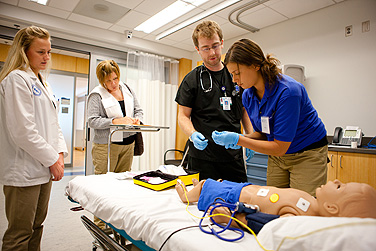News
Behling Simulation Center transforms
education for health sciences students

Students go through a simulation as part of the grand opening of the Behling Simulation Center. Photo: DOUGLAS LEVERE
-
 Print
Print -
 Comments
(1)
Comments
(1)
-
Multimedia

Behling Simulation Center promotes team-based health care delivery. Watch a video.
Before treating their first, live, human patient, UB students in the five health sciences schools will be able to safely practice a full range of medical procedures—from inserting catheters and delivering babies to resuscitating injured patients—thanks to the new Behling Simulation Center, which held its grand opening on Tuesday in Farber Hall, South Campus.
This new approach to health sciences education will result in graduates who are best prepared for the contemporary health care environment and for enhancing the health of Western New Yorkers, says Michael E. Cain, vice president for health sciences and dean of the School of Medicine and Biomedical Sciences.
“Just as health care professionals work as a team in the field, our students in all five of the health sciences schools will now be learning together as a team as well,” Cain says. “The Behling Center is breaking down the traditional educational silos between medicine, nursing, pharmacy, public health and dentistry. We are tremendously grateful to Dr. Behling and to all the other donors who have made this inter-professional educational center possible.”
Ralph Behling, who earned pharmacy and medical degrees from UB, committed $3 million for the center.
The opening of the simulation center was part of Inauguration Week events celebrating the investiture of Satish K. Tripathi as UB’s 15th president. Visit the Inauguration Week website for a recap of each day’s events.
Operating in pilot mode since last year and now in full-scale operation, the center has so far touched the lives of more than 500 UB students. It is expected that within this first year, it will have directly affected more than 1,000 UB students throughout all the health sciences disciplines. The center also will be used by area health care institutions and students from other schools.
The ability to affect so many generations of students motivated Behling to develop the simulation center.
“I think I’m contributing to education as a whole,” he says, “not only just to a one-year class, but it will be going on forever.”
UB continues to raise funds to create new programs for the center and purchase additional equipment.
“Simulation training is the future of resident and fellow clinical training in areas where experience is required before attempting the technique on real patients,” says Mark J. Lema, professor and chair of the Department of Anesthesiology and president of the Erie County Medical Society.
“Our students practice until they get it perfect and get over the learning curve so that the brain, the eyes and the hands are all working together,” says Jeffrey W. Myers, director of the Behling Simulation Center and an academic scholar in UB’s Department of Emergency Medicine.
Myers says the simulations also bring to light the complex social, ethical and interpersonal issues that health care professionals face every day.
“The simulations put the students right into a realistic situation where they have to think on their feet,” he says. “You can lecture about it until the cows come home but in the center, the students come face to face with family members whom they have to tell that their loved one is critically ill or dying. Until they are in that situation, they don’t know how they are going to deal with it.”
So far, the center has a library of about 55 simulation scenarios ranging from traumatic injury and pediatric septic shock to kidney disease problems and a pregnant teenager.
Students participate in four-hour sessions where they have the opportunity to either participate in or view four complete scenarios. After each scenario, all the students review the videotape and discuss what went right—and where they need to improve.
As faculty and administrators at UB’s five health sciences schools develop curricula for the center, they are finding new synergies between them.
“The faculty and deans who are working on the curriculum are learning from each other and about each other’s disciplines,” says Myers. “The center is the visible entity that is becoming a driving force in bringing all of the professions together.”
For more information, visit the Behling Simulation Center’s website.

Reader Comments
Elaine Mosher says:
This is great experience for the students.
Posted by Elaine Mosher, Medical Library Coordinator, 10/20/11